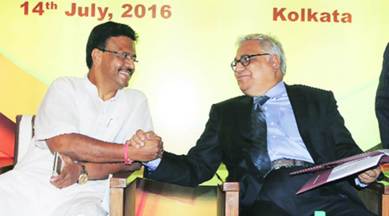Bangladesh-Bhutan-India-Nepal Business Summit: Citing work done by govt in last 5 years, ministers urge industry to invest heavily
“We are looking to develop one of the townships entirely by the private sector,” the minister announced, urging industrialists that “it is your turn to come forward now”.

Projecting West Bengal as an “investment friendly state” because of the “work done in the last five years”, state Urban Development Minister Firhad Hakim Thursday urged industrialists and entrepreneurs to “invest heavily”.
Speaking at the 88th AGM of the Indian Chamber of Commerce (ICC), Hakim said, “In the last five years, we in the Trinamool government, under the guidance of Chief Minister Mamata Banerjee, have worked hard to create a work culture in the state. We have created a structure and have also fast tracked and developed infrastructure. We have succeeded in developing a modern city which is amenable to investment from businesses and industry.”
monthly limit of free stories.
with an Express account.
Hakim said there were six smart cities planned for Bengal and five new townships on the anvil. “We are looking to develop one of the townships entirely by the private sector,” the minister announced, urging industrialists that “it is your turn to come forward now”.
[related-post]
Watch Video: What’s making news
“You will get all the support you need from the West Bengal government. I will ensure all the clearances are expedited. It is your turn, as the business community, to take the risk and invest in Bengal. Don’t let the recession get in the way. We want West Bengal to be on the fast track, and for that the businessman needs to run the fastest,” he said.
Earlier in the day, Kolkata Mayor Sovan Chatterjee also urged the business community to invest in the state, saying that the government of West Bengal was “looking at creating single window system to facilitate a seamless work atmosphere”.
“I am the Mayor of Kolkata. But I am also the Minister of Fire Services, and also the Minister of Environment, and also of Housing. The reason why I have been given these ministries along with my responsibilities as the mayors is very clear. The message the chief minister is giving out is that she wants to create a single window system, so that work is expedited, so that you don’t get caught in the mire of red tape like under the Left rule.
During the 34 years of the Left Front’s rule, little development could take place. Mainly because once the permission for a project has been given, red tape and the system of getting permissions from different departments was difficult. So the work was always both slow and remained incomplete,” Chatterjee said.
President, ICC, Shiv Siddhant Kaul said that the government also needed to chalk out a policy on land for industries. “Some governments create land banks. Others go for land acquisition. We, as the chamber of commerce, can help governments come to a consensus and decide which is desirable by involving all stakeholders, including land owners who must get compensation at the same beneficial rate as the industries,” said Kaul, adding that the issue of labour reforms in the state as well as the country also needed to be addressed for further growth.
“The eastern part of India has not grown as fast as it should have. It has traditionally been neglected as a less developed area or an area difficult to develop. This is a myth. India has been growing at eight-nine per cent per year. The IMF projects that the country will grow at 7.5 per cent in 2016-17 while the global growth rate will be 3.3 per cent. If India has to meet this growth rate, the only way will be to look eastward. In the meantime, the chamber of commerce will continue to try and build bridges between the eastern and western markets in the country,” he said.